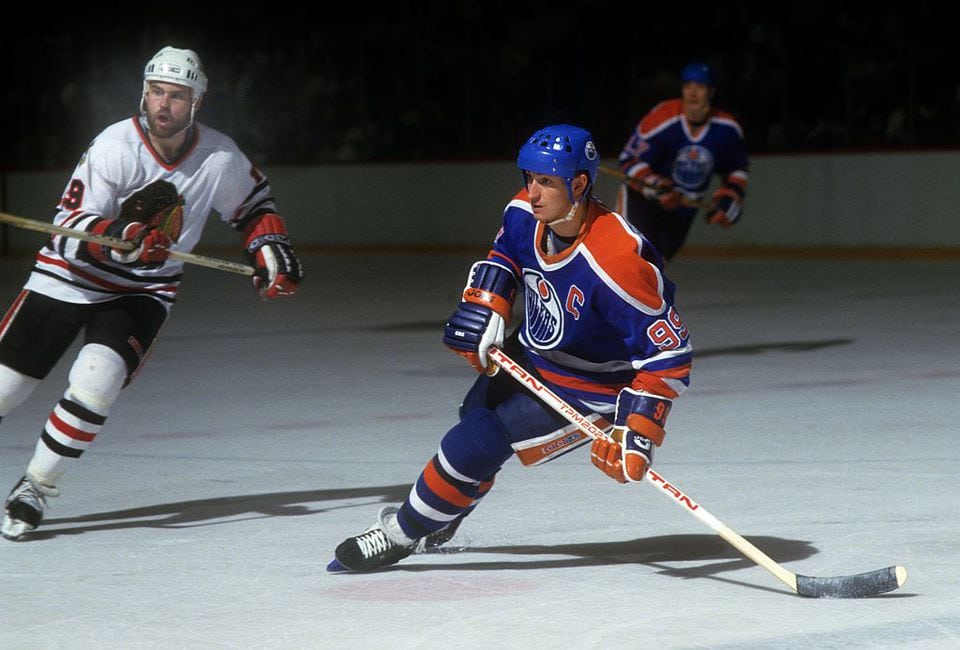
Wayne Gretzky, Mark Messier and Kevin Lowe retired from the National Hockey League with nothing to prove to their peers in the game. But on Oct. 10, 1979, they flew into O’Hare International Airport ready to show, not that they were elite, but that they belonged.
That was the night of the Edmonton Oilers’ first game in the NHL. After seven seasons in the World Hockey Association (WHA), the Oilers were taking the next step to the top hockey league on the planet.
No one on that flight—not even “The Great One” himself—was immune to the anxious energy of the trip.
“I’d never been that nervous before in my life,” Gretzky told Edmonton Journal reporter Terry Jones.
Messier, who was 18 years old at the time, was also trying not to let the enormity of the moment rattle him.
“All I could think about was, ‘We’re in the NHL.’ It got to me,” the future Hall of Famer said in Jones’ 1998 book Edmonton’s Hockey Knights: 79 to 99.
Ron Chipperfield, a 25-year-old centre who was named the first captain of the Oilers on Northwest Airlines Flight 458 to Chicago, conceded to feeling like a rookie, despite his five years of play in the WHA.
“The NHL is the place to play … I guess I can admit that now,” said Chipperfield.
Head coach Glen Sather, now the president of the New York Rangers, saw a team that was eager to show what it could do.
Glen Sather (Perry Nelson-USA TODAY Sports)
“All these guys are trying to prove they are good hockey players. They want to show these guys in the NHL that they’re good hockey players,” Sather told Jones.
“They’re excited. Now they have a chance to go and show it where everybody is going to notice.”
Game 1 Lineup for the Edmonton Oilers
While familiar names like Gretzky, Messier, Lowe, Lee Fogolin, Dave Semenko and Dave Lumley played in that first NHL game for the Oilers, the team had yet to round out its roster with the legendary talents of Glenn Anderson, Paul Coffey, Jari Kurri, Andy Moog and Grant Fuhr.
Dave Dryden—a 38-year-old netminder who had NHL experience with the Chicago Black Hawks, Buffalo Sabres and New York Rangers—was between the pipes for the Oilers, while Eddie Mio (Gretzky’s best man at his 1988 wedding to Janet Jones) was the backup goalie.
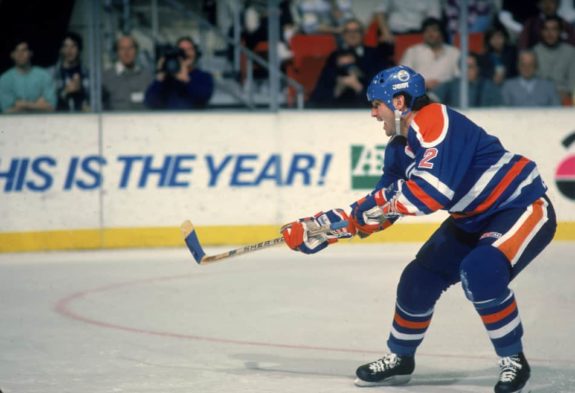
Lee Fogolin (Photo by Bruce Bennett Studios/Getty Images)
Fogolin and Lowe were joined by Doug Hicks, Risto Siltanen, Colin Campbell and Pat Price on the back end. Hicks, a product of Cold Lake, Alberta, was added from the Black Hawks through the 1979 expansion draft, and put together his best offensive season in his first year with the Oilers, scoring nine goals and 31 assists over 78 games.
Siltanen was another blueline threat for Edmonton. He put up 35 points in 1979-80 and would follow that up with a 53-point campaign in his second year in the NHL. The Finn hit his stride for the Oilers in 1981-82, when he notched 63 points in 63 games.
Campbell, who would eventually serve as the league’s chief disciplinarian before taking on his current role as the NHL’s executive vice president and director of hockey operations, led the team in penalty minutes during the Oilers’ inaugural campaign, racking up 196 minutes in the box.
Price, meanwhile, was another player who came to the Oilers via expansion draft. The former New York Islander was a well-rounded player who scored 11 goals, 32 points and served 134 penalty minutes in 1979-80.
Forward Depth: A Work in Progress
Gretzky was the obvious centre of attention during the Oilers’ transition to the NHL. During his one season in the WHA—which included eight games for the Indianapolis Racers and 72 for the Oilers—he looked like a superstar in the making, scoring 46 goals and 110 points, which was good for third in league scoring behind Robbie Ftorek and Real Cloutier.
The Brantford, Ontario native looked even better in his first tour of duty in the NHL. His 137 points—51 of which were goals—left Gretzky tied for the scoring lead with Marcel Dionne, who took home the Art Ross Trophy due to a higher goal total. While he missed out on that hardware, Gretzky did claim the Hart Memorial Trophy as the NHL’s most valuable player and the Lady Byng Memorial Trophy for sportsmanship and gentlemanly conduct.
Riding shotgun with Gretzky in 1979-80 was right winger Blair MacDonald, who scored 46 goals and 94 points before being traded to Vancouver next season (when Sather observed that a “fire hydrant” could score 40 goals playing with Gretzky).
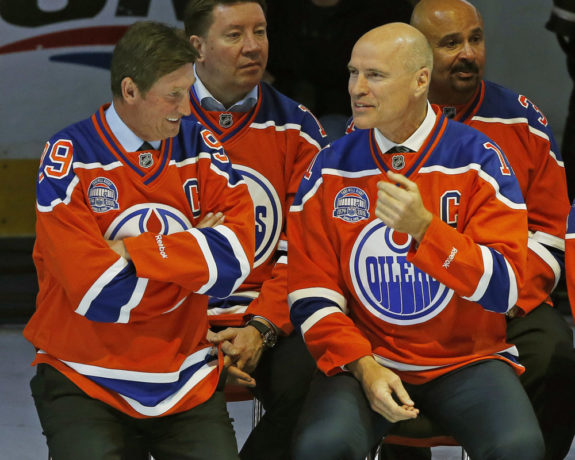
Wayne Gretzky (left) chats with Mark Messier (right) Perry Nelson-USA TODAY Sports
Messier had not yet established himself as a second-line centre, let alone one of the best leaders in hockey history. He spent most nights on the third line and only scored 33 points in his rookie campaign.
That left others to pick up the offensive slack. Chipperfield recorded 18 goals and 19 assists during 67 games for the Oilers before he was traded to the Quebec Nordiques for goaltender Ron Low on March 11, 1980. Another centre, Stan Weir, put in a solid season for Edmonton, scoring 33 goals and adding 33 helpers.
On the wings, Lumley and Brett Callighen each posted 58-point seasons, while Dave Hunter chipped in with 43 points. Semenko added six goals and seven assists but his role was not to put the puck in the net. The other forwards in that opening night lineup—right winger Bill Flett and left winger Peter Driscoll—would not remain in the NHL past the 1980-81 season.
The forward group provided some offensive punch—mostly from Gretzky—but the Oilers were yet to become the high-powered, goal-scoring force they would during much of the 1980s.
Puck Drop for the Oilers in the NHL
The opening faceoff at Chicago Stadium featured the 18-year-old Gretzky lining up at centre ice against Hall-of-Famer Stan Mikita in front of 9,000 fans.
It was a shaky start for the Oilers, who were down 2-0 by 2:33 of the first period. But a short time later, the franchise’s first NHL goal came from an unlikely source when Lowe’s backhander found the back of the net behind goalie Tony Esposito at the midway-point of the opening frame.
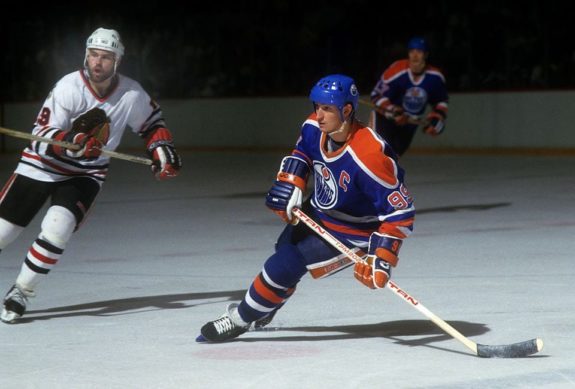
Wayne Gretzky brought one last glimmer of hope to the WHA but he was too young to save the league from financial woes. (Photo by B Bennett/Bruce Bennett Studios/Getty Images)
The power-play marker from Lowe—Edmonton’s first-ever draft pick, a 21st overall selection from the Quebec Remparts – was one for the Oiler record books. The assists went to Gretzky, who scooped up the historic puck and passed it to Lowe, and Callighen. Lowe only scored 84 goals during his 19 seasons in the NHL, but few were bigger than that one.
Before the end of the first period the Oilers would strike again when Hunter punched home a pass from Weir for the second goal in team history. Lumley also drew an assist on that goal, his first NHL point. The Oilers went into the first intermission trailing 3-2 and the Black Hawks added an insurance goal in the second period before securing a 4-2 win over Edmonton.
“They were a good-skating, hard-working team,” Mikita told reporters after the game. “They were trying to prove something and, as far as I’m concerned, they did.”
Mikita, who retired after playing just 16 more games, was not the only Black Hawk who was impressed.
“I was happy when it was over,” said Esposito in his postgame comments. “They did a tremendous job. If they continue to play like that, they’re going to surprise a lot of teams.”
A Season of Firsts for the Oilers
The game in Chicago checked off a lot of boxes for the Oilers, who are celebrating 40 years in the NHL this season – first shifts, first goals, first assists and the team’s first NHL loss.
More groundbreaking moments would follow. Messier scored his first goal during a 3-3 tie against the Detroit Red Wings at the Oilers’ home opener on Oct. 13, 1979. Edmonton’s next game, a 4-4 draw versus the Canucks, featured Gretzky’s first goal, which came on the power play.
Following a loss and two ties, the Oilers finally registered their first franchise win at Northlands Coliseum on Oct. 19—a 6-3 victory over the Quebec Nordiques.
By mid-season, they had compiled a 9-22-9 record and playoffs seemed unlikely. But Gretzky and his crew managed to turn things around in the second half and their 28-39-13 record was good enough for Edmonton to qualify for the 16th and final playoff spot. The Oilers were swept by the Philadelphia Flyers in the best-of-five series – they’d have to wait another year to earn their first playoff victory.
More to Prove: A Dynasty in the Making
When the 1979-80 NHL season wrapped up, the Oilers still had a lot to prove, but they did enough to show that they belonged in the league.
Lessons had been learned, by the players and the coaching staff, and success would follow.
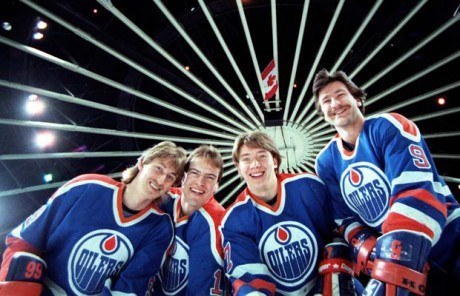
From left to right: Gretzky, Messier, Kurri and Anderson
Kurri, Fuhr, Moog, Anderson and Coffey would soon join Gretzky, Messier, Lowe and Semenko in Edmonton.
The first regular-season NHL wins the Oilers experienced in 1979 would soon be converted into first playoff wins, first postseason series victories and the team’s first Stanley Cup in 1984—the first of five.
Those Oiler teams have nothing left to prove.
Be the first to comment